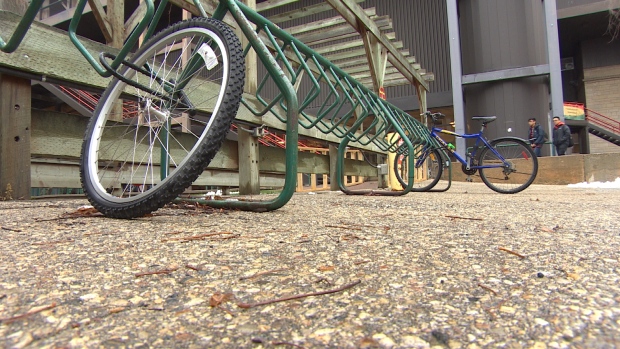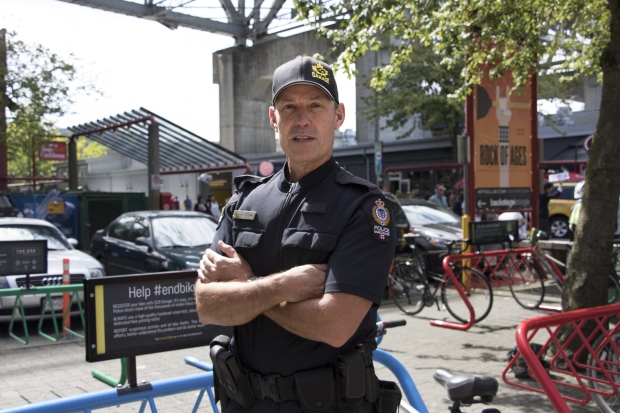The Cross Canada Cycle Tour Society May 2017, Volume 34, Issue #5
President’s Report John Pringle
SAFE CYCLING – AN ANNUAL SPRING CONCERN THAT BEGS A SOLUTION
There seems a penchant, a perceived need, a concern that with the arrival of spring the Club should be planting bits of safe cycling advice, as we would plant spring annuals along our driveways or front stoops. The good folks advocating on behalf of bicycle safety seem to think the messages dropped here and there along our communication pathways will be sufficiently attractive, say as a BC mountain spring flower bloom, to have Club members pay attention to their earnest words. Me thinks not. In Canada’s climate the passing of black and white winter landscapes along with the greyness of winter skies has us salivating for colour: Tiny crocuses and snow drops are ogled; hikes to distant mountains are made to view the glacier lily blooms. Sadly the sprouting of cycle safety literature has anything but the same appeal. Club members do stop to read about cycling; don’t get me wrong. Background reading for events such as “riding from Munich to Venice” or pedalling the Ottawa H & S, two of the many events on the Club’s 2017 event list, will be done with joy. But lists of “dos and don’ts” on cycling safety, to be read, digested and put into action upon lifting our rusty legs over the bar and resting our inflated derrieres on a tiny hard piece of leather following a winter of idleness, will be as appealing as a root canal or water boarding session.
Near the end of our March Board meeting discussion centred around a spring welcome letter aimed at new and returning Club members. Quickly the concept became a passed-motion as restless members shuffled paper and lunch debris into bags in preparation for departure. Then, as an afterthought, one member suggested a list of cycling safety measures be included in the posting. These had been collated by a conscientious senior Club member and sent to his local chapter. Good intentions we agreed, but maybe vetting the list should be in order? It was thus sent to Board members. Diversity of opinion coloured the responses. All felt it was a good first attempt; some were more enthusiastic; e.g., a couple felt it was so good that it be made available at waiver signing, where the signees would swear to read it. Another suggested it be sent to all members with a must-read sticker attached. But others felt, for it to be posted on the website as Club safety guidelines, “ … it would need a lot of work”. Interestingly, one Board member included with his response, a second list which also had been sent out to a Chapter membership.
What did the Board learn from this ad hoc approach: First, that chapters were leading the Board on the important policy issue of cycling safety. Secondly, that the approach to cycling safety policy can be diverse. One unifying factor was that both lists were written from the perspective of group riding. Not surprising as that’s what CCCTS does. But from that approach forward the two lists were quite different. For example, to communicate with fellow riders, one list concentrated on hand signalling; the other urged vocal commands. Which approach, if either, is superior? How would the Club decide? Is it important to have one one approach? Or should chapters continue to lead with a range of approaches?
I here suggest it would be remiss of the Board were it to shirk this important topic. Surely if there is one topic that should be top down it is safety guidelines. But only of course, if the Board can do a better job. And bearing in mind that, “Building concensus on a complete set of (safety) guidelines is an arduous task,” as one Board member noted.
Safety guidelines ended up on the agenda of the April Board meeting where no member has a safety background, nor is there anyone with an overwhelming interest in championing safety. Anecdotes sprinkled through the discussion, the gist of which showed how important the topic is:
- One told of a very experienced rider seeking riding company. He joined a local Club day ride, and later exclaimed with horror how unsafe that particular group was. He was not seen again;
- Similarly, a longtime Victoria couple is considering not rejoining in 2018 because of dangerous riding practices exhibited by certain local riders. As an example, one Victoria rider stopped at a red light, only to be run over by an inattentive fellow rider who later admitted to riding with “undo care and attention”; and,
- Another Board member noted an inverse relationship between age, experience and unsafe riding practices in his particular day ride group. He went on to note how difficult it was to remediate unsafe practices within this cohort.
Resolution of this Club safety conundrum must be resolved. It is obvious that the creation of a safe riding culture is first and foremost. That at its simplest, riders must agree to follow the rules of the road, and agree that they ride without causing harm to oneself or others. And that using common sense, discretion and attentiveness become guiding principles when riding with others. Once these are inculcated in the mindset of Club members, filling in the missing pieces should be doable.
We came to the conclusion that the messaging and marketing of Club safety guidelines is serious business: A task to be done by say a retired safety specialist. The Club’s safety champion should be one who has a background in safety, with a keen interest in developing a practical set of safety guidelines, and an ability to market these guidelines to Club members.
Thus dear members is there anyone out there in our CCCTS Nation that fits the above bill? If so please contact me (778-533-1440; knitsui@telus.net) or another Board member at your earliest convenience. We want to ensure that all members live to be able to ride through and smell the spring mountain flowers.
Welcome New Members
| Roger | Vermeulen | Comox | BC |
| Brenda | Latta | Courtenay | BC |
| Mike | Thompson | Courtenay | BC |
| Richard | Clynick | Ottawa | ON |
| Ruth | Clynick | Ottawa | ON |
| Richard | Lacy | Ottawa | ON |
| Debbie | Scott | Surrey | BC |
| Tom | Hughes | Vernon | BC |
| Brian | Fardoe | Victoria | BC |
| James | Henning | White Rock | BC |
Upcoming Hub and Spokes
Upcoming Tours
- 2017 Portland
- 2017 BC Lakes and Mountains
- 2017 Ireland – Wild Atlantic Way
- 2017 Munich to Venice
- 2017 Ottawa Valley
- 2017 Princeton
I first reported about 529 Grarage in June 2016.
Lack of revenue could sink anti-theft bicycle app used in B.C.
Thousands have registered bikes with 529 Garage, but app not sustainable without funding
By Rafferty Baker, CBC News Posted: Apr 25, 2017
According to police, 529 Garage has reduced bike thefts in the city. However, the app is run by a U.S. company that hasn’t secured funding. Photo of Rafferty Baker
J Allard’s truck was loaded up for a mountain biking trip to Whistler, B.C., when he left it parked in a Seattle parkade overnight a few years ago.
In the morning, Allard found his truck had been broken into. The bikes had been stolen and the holiday was ruined.
“It was devastating,” he said. “It spoiled the week, cost thousands and thousands of dollars.”
The ordeal led Allard to start developing an anti-theft app for cyclists. Owners post their bikes on the registry, including serial numbers and distinct characteristics that could lead to a stolen bike’s recovery.
Thousands of bikes have been registered with the project, called 529 Garage, since its launch in 2015. It appears to be making a difference for bike theft victims and police departments are even on board.
But despite those successes, it’s been a passion project for Allard and his partners, funded out of their own pockets and run on a shoe-string budget.
If Allard can’t generate a revenue stream soon, the app won’t be sustainable.
J Allard is the CEO of Project 529, a bike registry app. (Lara Ferroni)
“This is an epidemic. It’s a $500-million problem in North America,” Allard said of bike theft. “This just struck me right on the nose that there’s this $500-million enterprise that needs to be inoculated.”
Though he lives in Washington state, Allard — the man who once oversaw the development of the X-Box gaming system at Microsoft — chose Vancouver as the first city in which to test his app.
He found a strong ally at the local police department.
Bike theft a big problem in Vancouver
Const. Rob Brunt has embraced the bike registration app, advocating to the Vancouver Police Department and City of Vancouver officials on its behalf.
The officer assumed the role of Project 529 liaison for the entire province of B.C., getting at least 16 other municipalities on board.
Vancouver Police Const. Rob Brunt said 529 Garage has reduced bike theft in the city considerably, also reconnecting victims with their stolen bikes. (Tina Lovgreen/CBC)
“The public had really lost faith in [the police] when it came to bike theft,” said Brunt. “On a daily basis, I was seeing the impact on the community, but we weren’t seeing the returns by the police department.”
Brunt said about 2,400 bikes are recovered by police in Vancouver each year. Before the app was launched, owners were only found about two per cent of the time.
The rest of the bikes were held for 90 days before being sent to auction.
Now, Brunt says about 200 bikes recovered by the VPD — more than eight per cent — are returned to their owners each year. He suspects that many make it back to owners without police involvement because of the app.
He also credits a 20 per cent decrease in bike theft in the city to the project, which has about 17,000 bikes registered locally.
Money out, no money in
Allard doesn’t want to charge users to register their bikes or use advertising to pay company bills. Instead, he hopes to get to a point where he can collect licensing fees from municipalities.
Victims of bike theft can post their bikes on the 529 Garage app, with serial numbers and distinct characteristics that may lead to the bike’s recovery. (Rafferty Baker/CBC)
“It’s really just a matter of finding the right way to navigate the big cogs of government to find the right way to fund this,” he said.
“We’re rocking a lot of hours and working super hard to try to make this successful, and that’s just not sustainable,” said Allard.
“Really, the big bogey for us is this financial front … we just haven’t cracked that equation.”
It’s unclear when Allard and his team will hit a financial breaking point, or whether the revenue will start coming in before that happens. As it stands, a likely burnout could on the side of the bicycle thieves in B.C.
Newsbrief
Published at least ten times a year by The Cross Canada Cycle Tour Society, a non – profit organization for retired people and others who enjoy recreational cycling.
Items for the NEWSBRIEF must be received by the 28th of the month. The Editor reserves the right to edit for clarity, brevity and suitability of publication. The views expressed in the “NEWSBRIEF” are not necessarily those of the CCCTS or the Editor.
Submissions for NEWSBRIEF should be emailed to derailler@gmail.com
Please be sure to notify the office of any changes in your personal contact information; be it address, phone or e-mail.




